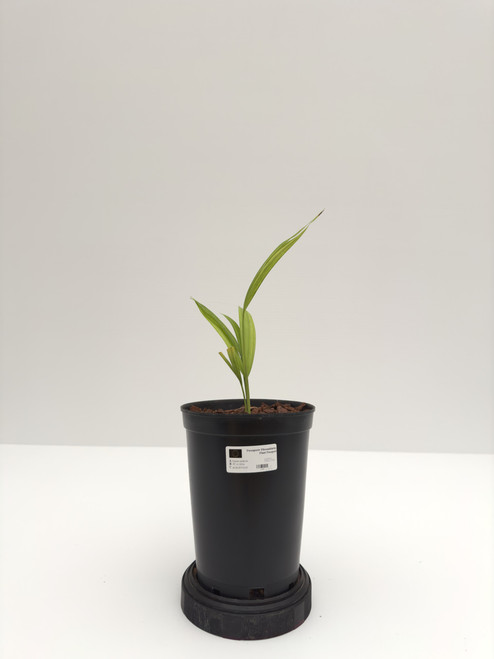Product Description
Habitat and Distribution
Said to occur in West Madagascar, but no voucher specimens from the wild are known. (1995).
Description
A medium sized, solitary palm with distinct rusty brownish-orange colored crownshaft that sports a fuzzy tomentum from which it's common name, The Teddybear Palm, comes from. The trunk can swell to a girth of about 6 inches and is distinctly ringed with the newest parts being green covered in a white powder. The leaves are exceptionally long with virtually no petiole. Often the leaflets get bent around in the wind and are held at various angles giving this palm a bit of a disheveled look, but the overall beauty is still not compromised. (J. Dransfield and H. Beentje. 1995)/Palmweb.
Solitary palm. TRUNK to 10 m high, 25 cm in diam., slightly flared at the base; internodes 12 cm, nodal scars 2 cm, white. LEAVES about 15 in the crown, porrect; sheath partially open in outer leaves, about 62 cm long, 5 mm thick, covered in dense rusty brown tomentum, with auricles 3.5 cm high; petiole 17 cm long, 7-9 cm wide, channelled adaxially, densely tomentose but glabrescent; rachis to 4 m long, proximally channelled and tomentose, more distally becoming flattened and eventually keeled distally, glabrous distally; pinnae up to 103 on each side of the rachis, regular, slightly drooping, green, linear, straight, acuminate, the proximal 55 x 0.5-0.8 cm, median 85 x 4 cm, distal 55 x 0.5-0.8 cm, glabrous but for some ramenta on the proximal part of the midrib abaxially, main veins 3. INFLORESCENCE interfoliar becoming infrafoliar in fruit, branched to 3 orders, to 1.7 x 1.4 m; peduncle to 65 cm long, 11 cm in diam. proximally, 3-6 cm in diam. distally, flattened, reddish tomentose over green; prophyll ± woody, about 43 cm, borne at 12 cm above the base of the peduncle, about 12 cm wide, tomentose; peduncular bract deciduous, woody, inserted at 26 cm from the base of the peduncle, to 70 x 10-15 cm, reddish tomentose; two smaller peduncular bracts present near the apex of the peduncle, to 17 cm long, tomen-tose; rachis 100 cm, flattened, grey-tomentellous, with 24 first order branches; rachis bracts to 3 cm long; rachillae spreading, to 30 cm long, 3 mm in diam., green; with distant triads in pits; rachilla bract 0.5-0.75 mm high. STAMINATE FLOWERS with sepals 2-2.5 mm, keeled, truncate; petals on a 1 mm high receptacle, 2 x 1.5-1.75 mm, ovate, acute; stamens said to be connate for 1.75 mm, filaments 0.8-1 mm long, anthers 1 mm long, dorsifixed?; pistillode 1.75-2 mm, columnar. PISTILLATE FLOWERS with sepals 2 mm; petals 3 x 3 mm; gynoecium 4 mm high, 2-2.5 mm in diam., with 1 mm long stigma lobes. FRUIT globose, dark brown, 10-12 mm; endocarp fibrous, the fibres anastomosing rather intensely. SEED 8.5-10 x 8.5-9 mm, globose, pointed at the base, rounded at the apex, with a subbasal depression corresponding to the embryo; ruminations of the endosperm irregular, to 3.5 mm deep and up to half the diameter of the seed wide. EOPHYLL pinnate. Close to D. lastelliana but differs in rachilla bract (thinner in leptocheilos), and fruit/seed size. (J. Dransfield and H. Beentje. 1995)/Palmweb. Editing by edric.
Close to D. lastelliana but differs in rachilla bract (thinner in leptocheilos), and fruit/seed size. Differences enumerated in the protologue with another species of Dypsis (it is unclear which one). (J. Dransfield and H. Beentje. 1995)/Palmweb.
Culture
Loves water and responds well to fertilizer. Grows in bright filtered light to full sun but can get leggy and ratty looking if grown in lower light levels, therefore full sun tends to produce a more beautiful palm. Can handle a light frost with damage but usually will recover with no lasting effects. Cold Hardiness Zone: 10a
Comments and Curiosities
Some D. leptocheilos exibit a heel and some don't.
Conservation: Unknown, until the status in the wild has become more clear. (J. Dransfield and H. Beentje. 1995)/Palmweb.
















